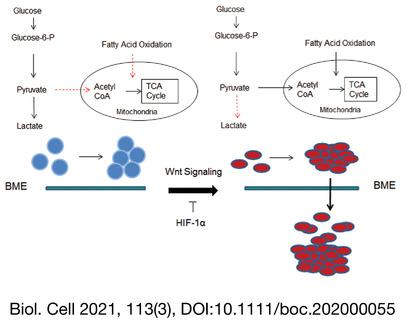当前位置:
X-MOL 学术
›
Biol. Cell
›
论文详情
Our official English website, www.x-mol.net, welcomes your feedback! (Note: you will need to create a separate account there.)
Activation of Wnt/β‐catenin signaling and HIF1α Stabilization Alters Pluripotency and Differentiation/Proliferation Properties of Human Induced Pluripotent Stem Cells
Biology of the Cell ( IF 2.7 ) Pub Date : 2020-12-16 , DOI: 10.1111/boc.202000055 Hua Wei 1 , Gyda C Beeson 2 , Zhiwei Ye 3 , Jie Zhang 3 , Hai Yao 4, 5 , Brooke Damon 5 , Martin Morad 1
Biology of the Cell ( IF 2.7 ) Pub Date : 2020-12-16 , DOI: 10.1111/boc.202000055 Hua Wei 1 , Gyda C Beeson 2 , Zhiwei Ye 3 , Jie Zhang 3 , Hai Yao 4, 5 , Brooke Damon 5 , Martin Morad 1
Affiliation

|
BACKGROUND INFORMATION
Wnt/β-catenin signaling, in the microenvironment of pluripotent stem cells (PSCs), plays a critical role in their differentiation and proliferation. Contradictory reports on the role of Wnt/β-catenin signaling in PSCs self-renewal and differentiation, however, render these mechanisms largely unclear. RESULTS
Wnt/β-catenin signaling pathway in human induced pluripotent stem cells (hiPSCs) was activated by inhibiting GSK3, driving the cells into a mesodermal/mesenchymal state, exhibiting proliferative, invasive, and anchorage-independent growth properties, where over 70% of cell population became CD 44 (+)/ CD133 (+). Wnt/β-catenin signaling activation also altered the metabolic state of hiPSCs from aerobic glycolysis to oxidative metabolism and changed their drug and oxidative stress sensitivities. These effects of GSK3 inhibition were suppressed in HIF1α-stabilized cells. CONCLUSIONS
Persistent activation of Wnt/β-catenin signaling endows hiPSCs with proliferative/invasive "teratoma-like" states, shifting their metabolic dependence, and allowing HIF1α-stabilization to inhibit their proliferative/invasive properties. SIGNIFICANCE
The hiPSC potential to differentiate into 'teratoma-like' cells suggest that stem cells states may exist in two states with differential metabolic and drug dependency. This article is protected by copyright. All rights reserved.
中文翻译:

Wnt/β-catenin 信号传导和 HIF1α 稳定性的激活改变了人诱导多能干细胞的多能性和分化/增殖特性
背景信息 Wnt/β-catenin 信号传导在多能干细胞 (PSC) 的微环境中,在其分化和增殖中起关键作用。然而,关于 Wnt/β-catenin 信号在 PSC 自我更新和分化中的作用的自相矛盾的报道使这些机制在很大程度上不清楚。结果 人诱导多能干细胞 (hiPSCs) 中的 Wnt/β-catenin 信号通路通过抑制 GSK3 被激活,驱动细胞进入中胚层/间充质状态,表现出增殖、侵袭性和不依赖贴壁的生长特性,其中超过 70%细胞群变成 CD 44 (+)/ CD133 (+)。Wnt/β-catenin 信号激活也改变了 hiPSCs 从有氧糖酵解到氧化代谢的代谢状态,并改变了它们的药物和氧化应激敏感性。GSK3 抑制的这些作用在 HIF1α 稳定的细胞中受到抑制。结论 Wnt/β-catenin 信号的持续激活赋予 hiPSC 增殖/侵袭性“畸胎瘤样”状态,改变其代谢依赖性,并允许 HIF1α 稳定化抑制其增殖/侵袭性特性。意义 hiPSC 分化为“畸胎瘤样”细胞的潜力表明干细胞状态可能存在于具有不同代谢和药物依赖性的两种状态。本文受版权保护。版权所有。并允许 HIF1α 稳定来抑制其增殖/侵袭特性。意义 hiPSC 分化为“畸胎瘤样”细胞的潜力表明干细胞状态可能存在于具有不同代谢和药物依赖性的两种状态。本文受版权保护。版权所有。并允许 HIF1α 稳定来抑制其增殖/侵袭特性。意义 hiPSC 分化为“畸胎瘤样”细胞的潜力表明干细胞状态可能存在于具有不同代谢和药物依赖性的两种状态。本文受版权保护。版权所有。
更新日期:2020-12-16
中文翻译:

Wnt/β-catenin 信号传导和 HIF1α 稳定性的激活改变了人诱导多能干细胞的多能性和分化/增殖特性
背景信息 Wnt/β-catenin 信号传导在多能干细胞 (PSC) 的微环境中,在其分化和增殖中起关键作用。然而,关于 Wnt/β-catenin 信号在 PSC 自我更新和分化中的作用的自相矛盾的报道使这些机制在很大程度上不清楚。结果 人诱导多能干细胞 (hiPSCs) 中的 Wnt/β-catenin 信号通路通过抑制 GSK3 被激活,驱动细胞进入中胚层/间充质状态,表现出增殖、侵袭性和不依赖贴壁的生长特性,其中超过 70%细胞群变成 CD 44 (+)/ CD133 (+)。Wnt/β-catenin 信号激活也改变了 hiPSCs 从有氧糖酵解到氧化代谢的代谢状态,并改变了它们的药物和氧化应激敏感性。GSK3 抑制的这些作用在 HIF1α 稳定的细胞中受到抑制。结论 Wnt/β-catenin 信号的持续激活赋予 hiPSC 增殖/侵袭性“畸胎瘤样”状态,改变其代谢依赖性,并允许 HIF1α 稳定化抑制其增殖/侵袭性特性。意义 hiPSC 分化为“畸胎瘤样”细胞的潜力表明干细胞状态可能存在于具有不同代谢和药物依赖性的两种状态。本文受版权保护。版权所有。并允许 HIF1α 稳定来抑制其增殖/侵袭特性。意义 hiPSC 分化为“畸胎瘤样”细胞的潜力表明干细胞状态可能存在于具有不同代谢和药物依赖性的两种状态。本文受版权保护。版权所有。并允许 HIF1α 稳定来抑制其增殖/侵袭特性。意义 hiPSC 分化为“畸胎瘤样”细胞的潜力表明干细胞状态可能存在于具有不同代谢和药物依赖性的两种状态。本文受版权保护。版权所有。



























 京公网安备 11010802027423号
京公网安备 11010802027423号